Business Strategy Analysis: Vodafone's Strategic Positioning Report
VerifiedAdded on 2020/10/04
|19
|6300
|407
Report
AI Summary
This report provides a comprehensive analysis of Vodafone's business strategy, examining the influence of the macro environment through PESTLE analysis, strategic positioning using Ansoff's matrix, and strategic capabilities using the VRIN model. It evaluates the competitiveness of the UK telecommunications sector using Porter's Five Forces model, identifies strengths and weaknesses, and analyzes strategic options using Bowman's strategy clock. The report highlights the impact of political, economic, socio-cultural, technological, legal, and environmental factors on Vodafone's operations and strategic decisions. It emphasizes the importance of market penetration and product development strategies for growth and competitiveness. Furthermore, the report discusses Vodafone's strategic capabilities in innovation, market research, and leadership, as well as the need for adaptability in a dynamic market environment. The analysis underscores the challenges posed by rising costs, legal issues, and the need to meet evolving customer demands while maintaining a competitive edge in the global telecommunications sector.
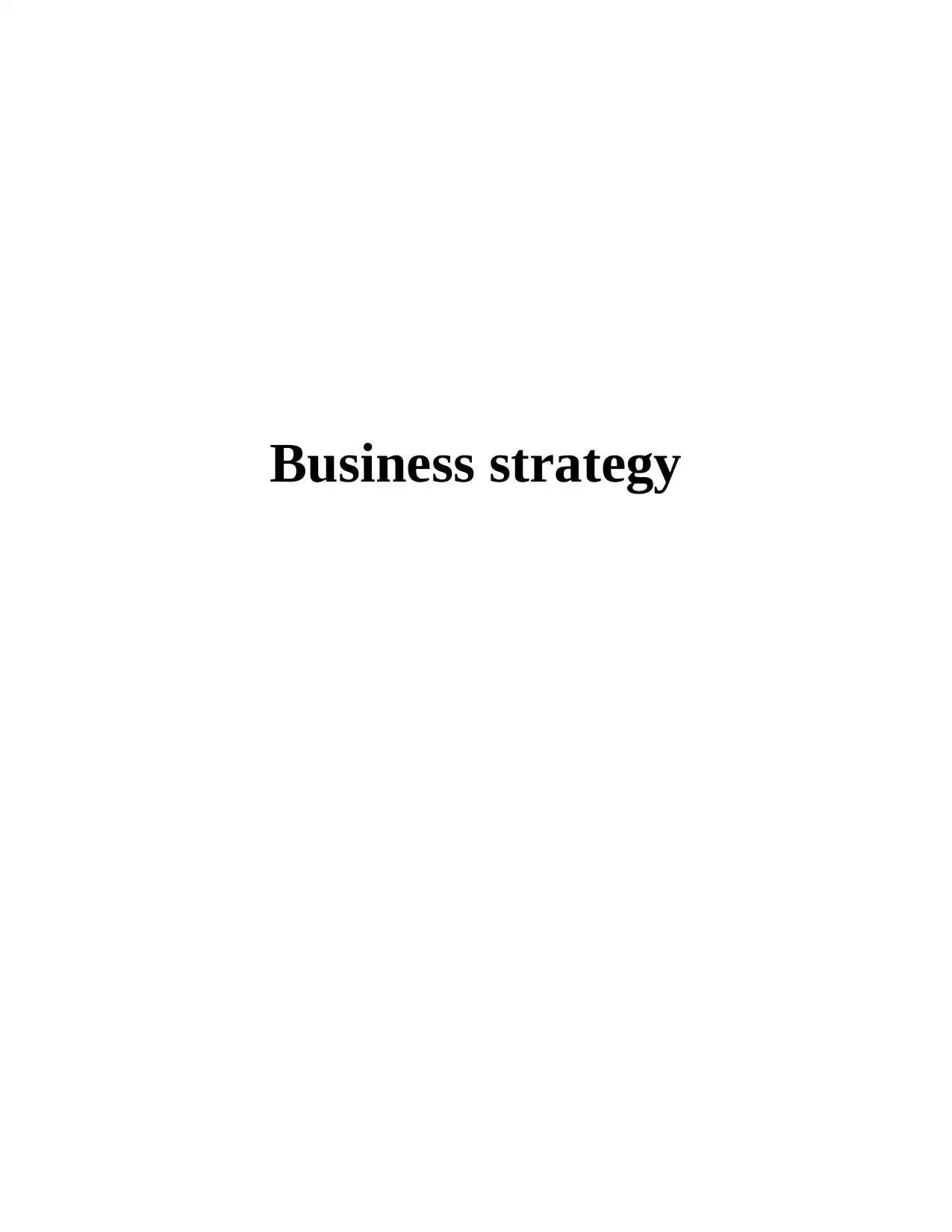
Business strategy
Paraphrase This Document
Need a fresh take? Get an instant paraphrase of this document with our AI Paraphraser
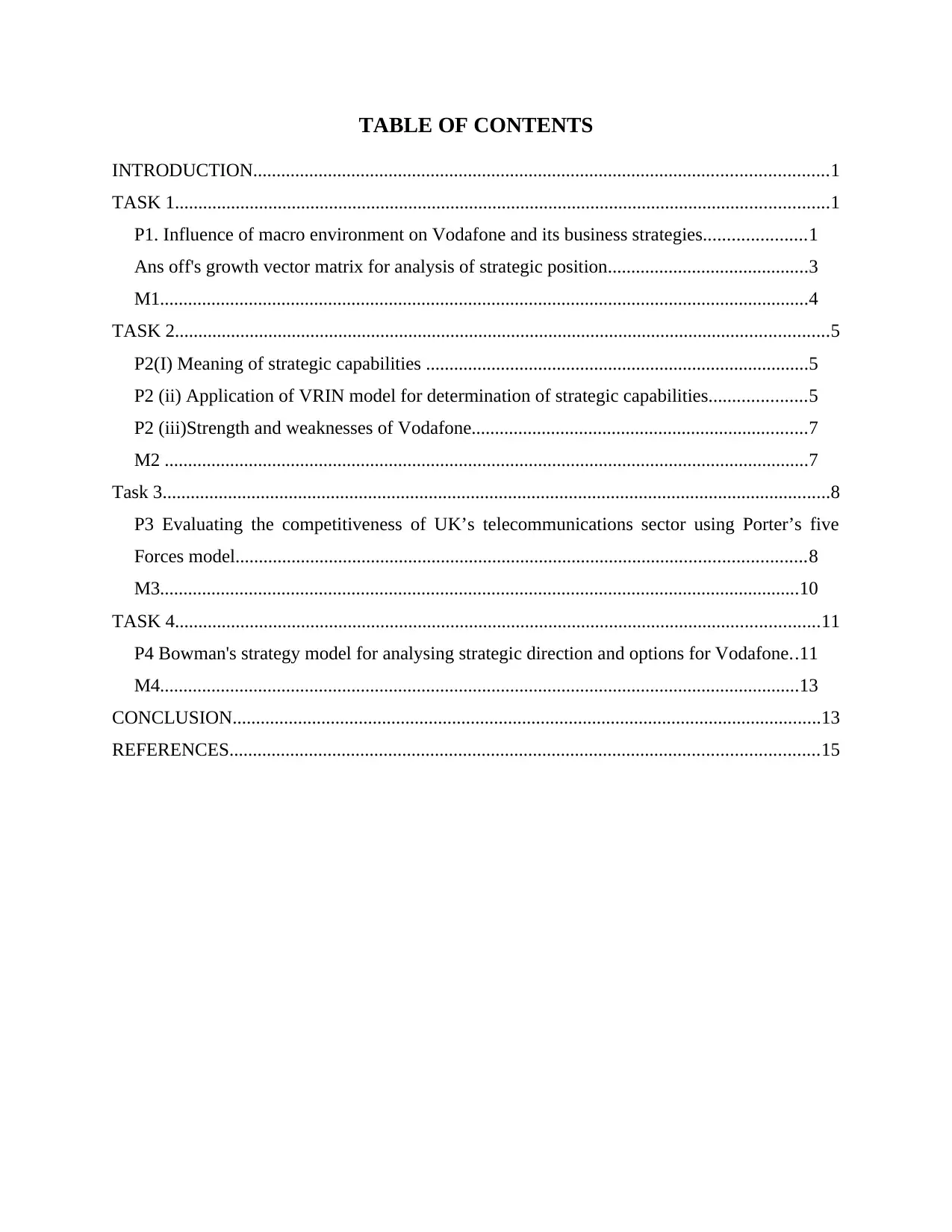
TABLE OF CONTENTS
INTRODUCTION...........................................................................................................................1
TASK 1............................................................................................................................................1
P1. Influence of macro environment on Vodafone and its business strategies......................1
Ans off's growth vector matrix for analysis of strategic position...........................................3
M1...........................................................................................................................................4
TASK 2............................................................................................................................................5
P2(I) Meaning of strategic capabilities ..................................................................................5
P2 (ii) Application of VRIN model for determination of strategic capabilities.....................5
P2 (iii)Strength and weaknesses of Vodafone........................................................................7
M2 ..........................................................................................................................................7
Task 3...............................................................................................................................................8
P3 Evaluating the competitiveness of UK’s telecommunications sector using Porter’s five
Forces model..........................................................................................................................8
M3.........................................................................................................................................10
TASK 4..........................................................................................................................................11
P4 Bowman's strategy model for analysing strategic direction and options for Vodafone..11
M4.........................................................................................................................................13
CONCLUSION..............................................................................................................................13
REFERENCES..............................................................................................................................15
INTRODUCTION...........................................................................................................................1
TASK 1............................................................................................................................................1
P1. Influence of macro environment on Vodafone and its business strategies......................1
Ans off's growth vector matrix for analysis of strategic position...........................................3
M1...........................................................................................................................................4
TASK 2............................................................................................................................................5
P2(I) Meaning of strategic capabilities ..................................................................................5
P2 (ii) Application of VRIN model for determination of strategic capabilities.....................5
P2 (iii)Strength and weaknesses of Vodafone........................................................................7
M2 ..........................................................................................................................................7
Task 3...............................................................................................................................................8
P3 Evaluating the competitiveness of UK’s telecommunications sector using Porter’s five
Forces model..........................................................................................................................8
M3.........................................................................................................................................10
TASK 4..........................................................................................................................................11
P4 Bowman's strategy model for analysing strategic direction and options for Vodafone..11
M4.........................................................................................................................................13
CONCLUSION..............................................................................................................................13
REFERENCES..............................................................................................................................15
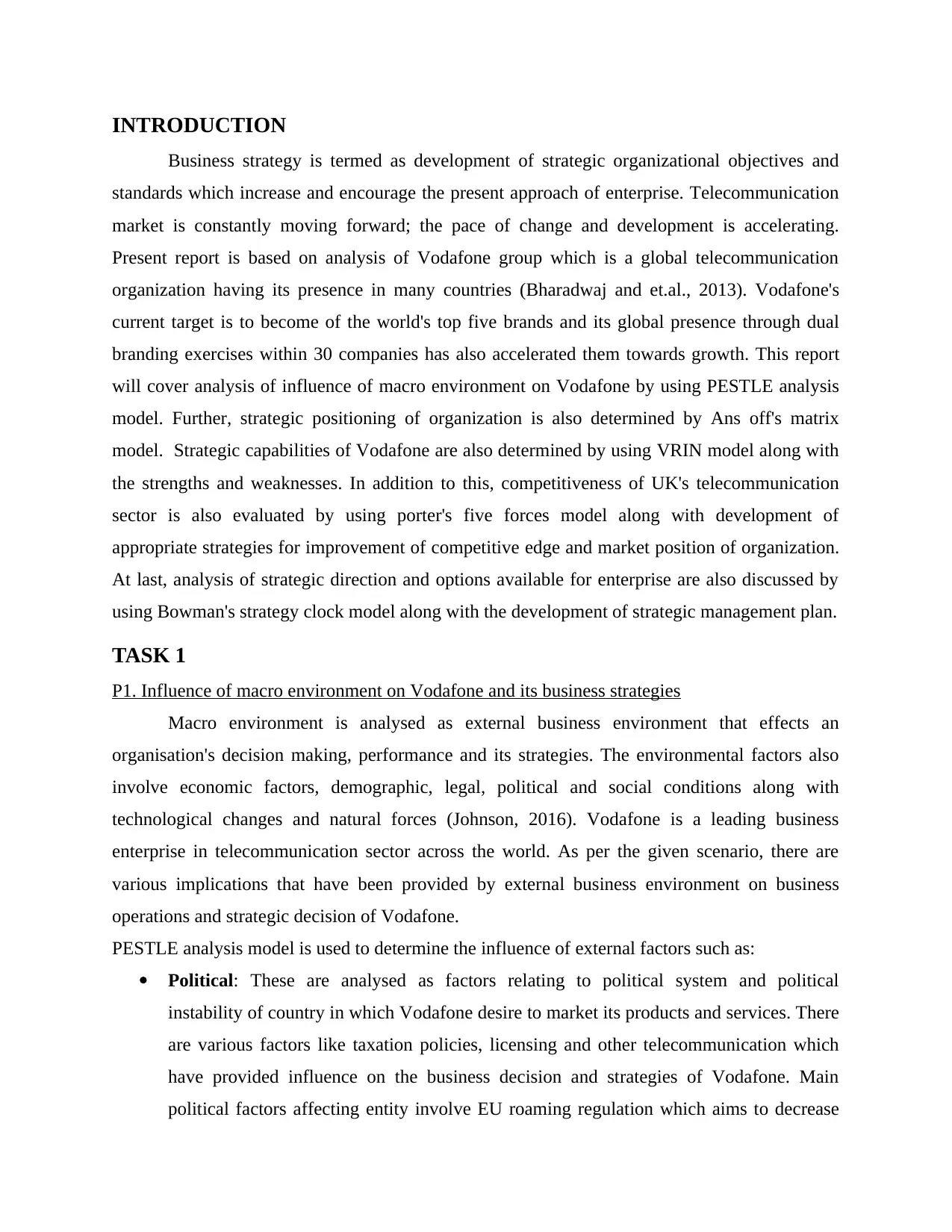
INTRODUCTION
Business strategy is termed as development of strategic organizational objectives and
standards which increase and encourage the present approach of enterprise. Telecommunication
market is constantly moving forward; the pace of change and development is accelerating.
Present report is based on analysis of Vodafone group which is a global telecommunication
organization having its presence in many countries (Bharadwaj and et.al., 2013). Vodafone's
current target is to become of the world's top five brands and its global presence through dual
branding exercises within 30 companies has also accelerated them towards growth. This report
will cover analysis of influence of macro environment on Vodafone by using PESTLE analysis
model. Further, strategic positioning of organization is also determined by Ans off's matrix
model. Strategic capabilities of Vodafone are also determined by using VRIN model along with
the strengths and weaknesses. In addition to this, competitiveness of UK's telecommunication
sector is also evaluated by using porter's five forces model along with development of
appropriate strategies for improvement of competitive edge and market position of organization.
At last, analysis of strategic direction and options available for enterprise are also discussed by
using Bowman's strategy clock model along with the development of strategic management plan.
TASK 1
P1. Influence of macro environment on Vodafone and its business strategies
Macro environment is analysed as external business environment that effects an
organisation's decision making, performance and its strategies. The environmental factors also
involve economic factors, demographic, legal, political and social conditions along with
technological changes and natural forces (Johnson, 2016). Vodafone is a leading business
enterprise in telecommunication sector across the world. As per the given scenario, there are
various implications that have been provided by external business environment on business
operations and strategic decision of Vodafone.
PESTLE analysis model is used to determine the influence of external factors such as:
Political: These are analysed as factors relating to political system and political
instability of country in which Vodafone desire to market its products and services. There
are various factors like taxation policies, licensing and other telecommunication which
have provided influence on the business decision and strategies of Vodafone. Main
political factors affecting entity involve EU roaming regulation which aims to decrease
Business strategy is termed as development of strategic organizational objectives and
standards which increase and encourage the present approach of enterprise. Telecommunication
market is constantly moving forward; the pace of change and development is accelerating.
Present report is based on analysis of Vodafone group which is a global telecommunication
organization having its presence in many countries (Bharadwaj and et.al., 2013). Vodafone's
current target is to become of the world's top five brands and its global presence through dual
branding exercises within 30 companies has also accelerated them towards growth. This report
will cover analysis of influence of macro environment on Vodafone by using PESTLE analysis
model. Further, strategic positioning of organization is also determined by Ans off's matrix
model. Strategic capabilities of Vodafone are also determined by using VRIN model along with
the strengths and weaknesses. In addition to this, competitiveness of UK's telecommunication
sector is also evaluated by using porter's five forces model along with development of
appropriate strategies for improvement of competitive edge and market position of organization.
At last, analysis of strategic direction and options available for enterprise are also discussed by
using Bowman's strategy clock model along with the development of strategic management plan.
TASK 1
P1. Influence of macro environment on Vodafone and its business strategies
Macro environment is analysed as external business environment that effects an
organisation's decision making, performance and its strategies. The environmental factors also
involve economic factors, demographic, legal, political and social conditions along with
technological changes and natural forces (Johnson, 2016). Vodafone is a leading business
enterprise in telecommunication sector across the world. As per the given scenario, there are
various implications that have been provided by external business environment on business
operations and strategic decision of Vodafone.
PESTLE analysis model is used to determine the influence of external factors such as:
Political: These are analysed as factors relating to political system and political
instability of country in which Vodafone desire to market its products and services. There
are various factors like taxation policies, licensing and other telecommunication which
have provided influence on the business decision and strategies of Vodafone. Main
political factors affecting entity involve EU roaming regulation which aims to decrease
⊘ This is a preview!⊘
Do you want full access?
Subscribe today to unlock all pages.

Trusted by 1+ million students worldwide
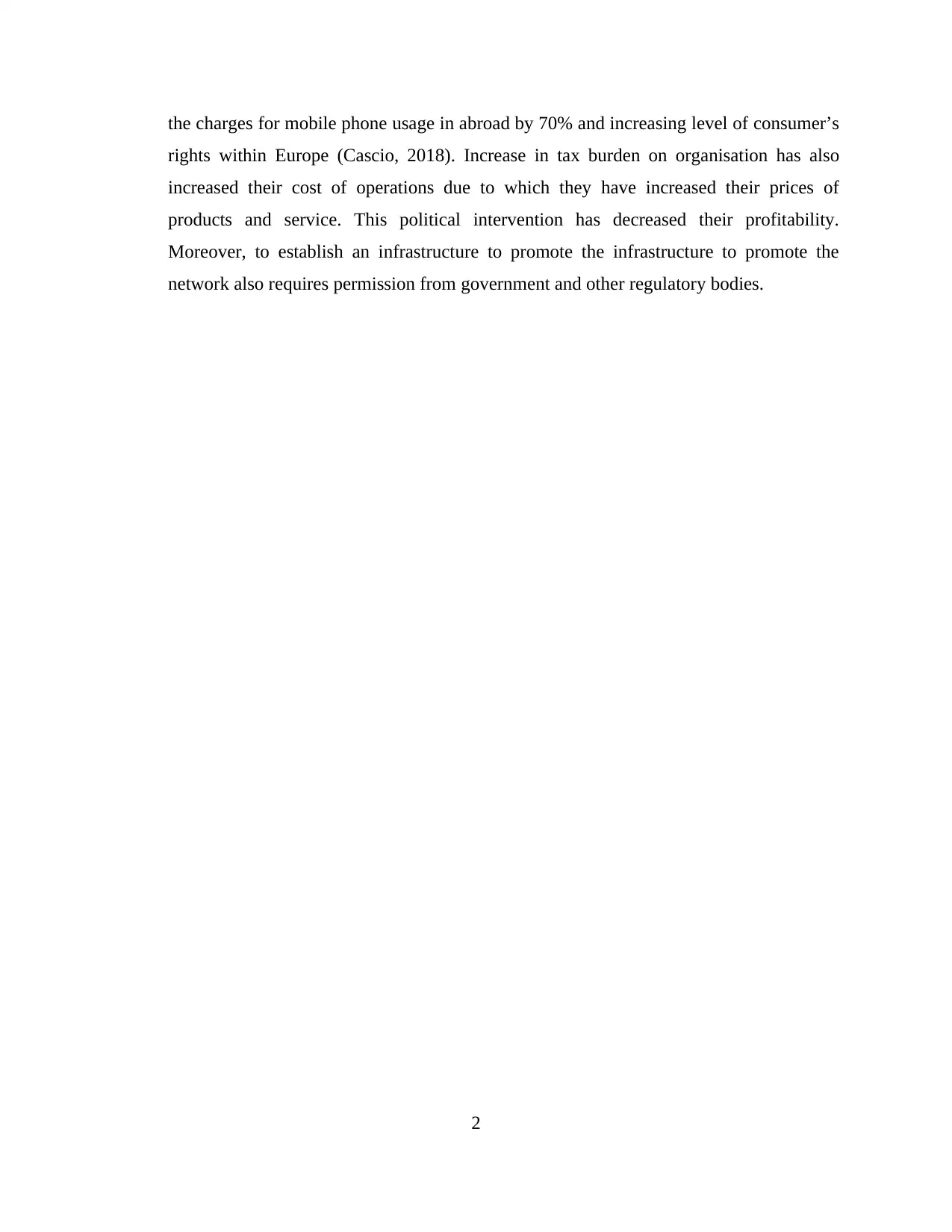
the charges for mobile phone usage in abroad by 70% and increasing level of consumer’s
rights within Europe (Cascio, 2018). Increase in tax burden on organisation has also
increased their cost of operations due to which they have increased their prices of
products and service. This political intervention has decreased their profitability.
Moreover, to establish an infrastructure to promote the infrastructure to promote the
network also requires permission from government and other regulatory bodies.
2
rights within Europe (Cascio, 2018). Increase in tax burden on organisation has also
increased their cost of operations due to which they have increased their prices of
products and service. This political intervention has decreased their profitability.
Moreover, to establish an infrastructure to promote the infrastructure to promote the
network also requires permission from government and other regulatory bodies.
2
Paraphrase This Document
Need a fresh take? Get an instant paraphrase of this document with our AI Paraphraser
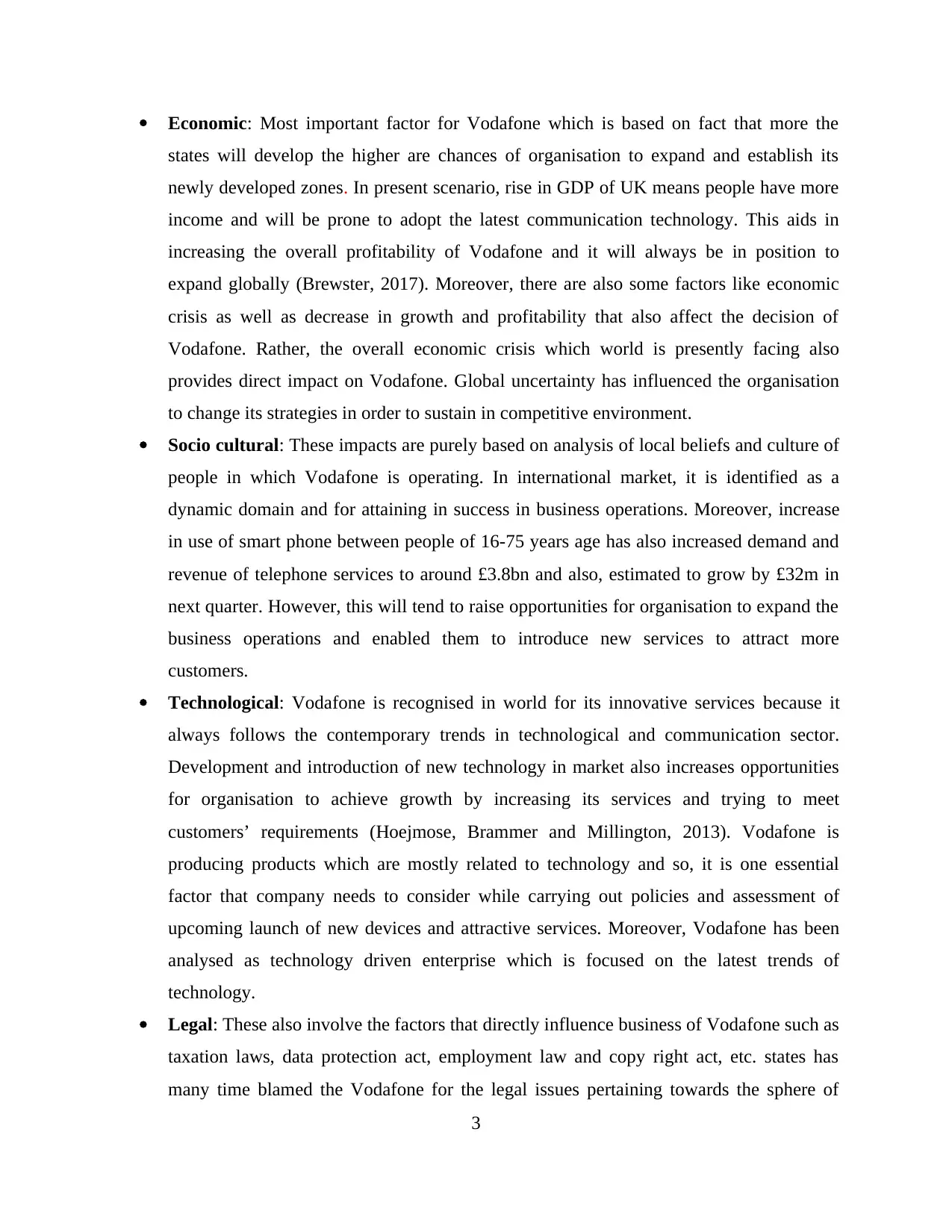
Economic: Most important factor for Vodafone which is based on fact that more the
states will develop the higher are chances of organisation to expand and establish its
newly developed zones. In present scenario, rise in GDP of UK means people have more
income and will be prone to adopt the latest communication technology. This aids in
increasing the overall profitability of Vodafone and it will always be in position to
expand globally (Brewster, 2017). Moreover, there are also some factors like economic
crisis as well as decrease in growth and profitability that also affect the decision of
Vodafone. Rather, the overall economic crisis which world is presently facing also
provides direct impact on Vodafone. Global uncertainty has influenced the organisation
to change its strategies in order to sustain in competitive environment.
Socio cultural: These impacts are purely based on analysis of local beliefs and culture of
people in which Vodafone is operating. In international market, it is identified as a
dynamic domain and for attaining in success in business operations. Moreover, increase
in use of smart phone between people of 16-75 years age has also increased demand and
revenue of telephone services to around £3.8bn and also, estimated to grow by £32m in
next quarter. However, this will tend to raise opportunities for organisation to expand the
business operations and enabled them to introduce new services to attract more
customers.
Technological: Vodafone is recognised in world for its innovative services because it
always follows the contemporary trends in technological and communication sector.
Development and introduction of new technology in market also increases opportunities
for organisation to achieve growth by increasing its services and trying to meet
customers’ requirements (Hoejmose, Brammer and Millington, 2013). Vodafone is
producing products which are mostly related to technology and so, it is one essential
factor that company needs to consider while carrying out policies and assessment of
upcoming launch of new devices and attractive services. Moreover, Vodafone has been
analysed as technology driven enterprise which is focused on the latest trends of
technology.
Legal: These also involve the factors that directly influence business of Vodafone such as
taxation laws, data protection act, employment law and copy right act, etc. states has
many time blamed the Vodafone for the legal issues pertaining towards the sphere of
3
states will develop the higher are chances of organisation to expand and establish its
newly developed zones. In present scenario, rise in GDP of UK means people have more
income and will be prone to adopt the latest communication technology. This aids in
increasing the overall profitability of Vodafone and it will always be in position to
expand globally (Brewster, 2017). Moreover, there are also some factors like economic
crisis as well as decrease in growth and profitability that also affect the decision of
Vodafone. Rather, the overall economic crisis which world is presently facing also
provides direct impact on Vodafone. Global uncertainty has influenced the organisation
to change its strategies in order to sustain in competitive environment.
Socio cultural: These impacts are purely based on analysis of local beliefs and culture of
people in which Vodafone is operating. In international market, it is identified as a
dynamic domain and for attaining in success in business operations. Moreover, increase
in use of smart phone between people of 16-75 years age has also increased demand and
revenue of telephone services to around £3.8bn and also, estimated to grow by £32m in
next quarter. However, this will tend to raise opportunities for organisation to expand the
business operations and enabled them to introduce new services to attract more
customers.
Technological: Vodafone is recognised in world for its innovative services because it
always follows the contemporary trends in technological and communication sector.
Development and introduction of new technology in market also increases opportunities
for organisation to achieve growth by increasing its services and trying to meet
customers’ requirements (Hoejmose, Brammer and Millington, 2013). Vodafone is
producing products which are mostly related to technology and so, it is one essential
factor that company needs to consider while carrying out policies and assessment of
upcoming launch of new devices and attractive services. Moreover, Vodafone has been
analysed as technology driven enterprise which is focused on the latest trends of
technology.
Legal: These also involve the factors that directly influence business of Vodafone such as
taxation laws, data protection act, employment law and copy right act, etc. states has
many time blamed the Vodafone for the legal issues pertaining towards the sphere of
3
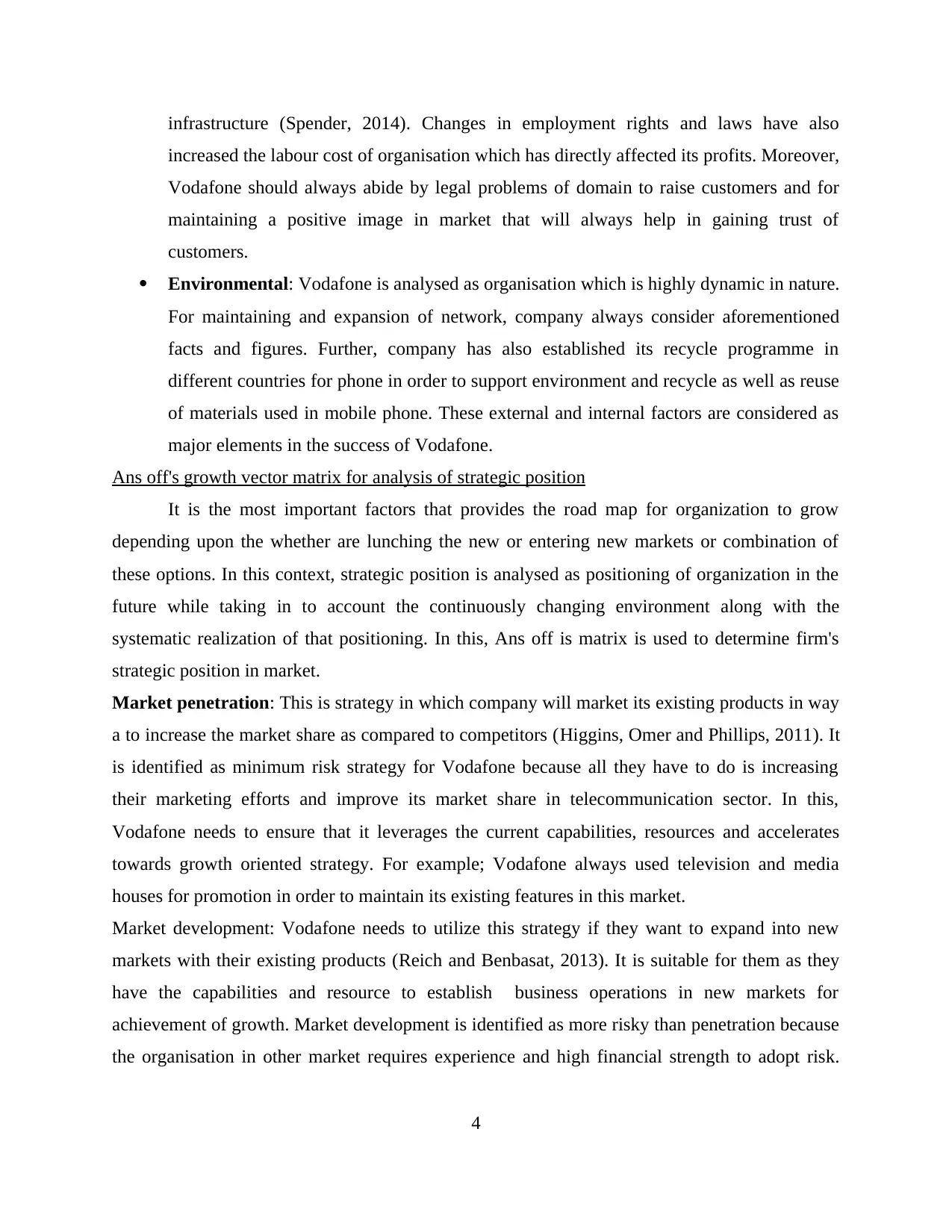
infrastructure (Spender, 2014). Changes in employment rights and laws have also
increased the labour cost of organisation which has directly affected its profits. Moreover,
Vodafone should always abide by legal problems of domain to raise customers and for
maintaining a positive image in market that will always help in gaining trust of
customers.
Environmental: Vodafone is analysed as organisation which is highly dynamic in nature.
For maintaining and expansion of network, company always consider aforementioned
facts and figures. Further, company has also established its recycle programme in
different countries for phone in order to support environment and recycle as well as reuse
of materials used in mobile phone. These external and internal factors are considered as
major elements in the success of Vodafone.
Ans off's growth vector matrix for analysis of strategic position
It is the most important factors that provides the road map for organization to grow
depending upon the whether are lunching the new or entering new markets or combination of
these options. In this context, strategic position is analysed as positioning of organization in the
future while taking in to account the continuously changing environment along with the
systematic realization of that positioning. In this, Ans off is matrix is used to determine firm's
strategic position in market.
Market penetration: This is strategy in which company will market its existing products in way
a to increase the market share as compared to competitors (Higgins, Omer and Phillips, 2011). It
is identified as minimum risk strategy for Vodafone because all they have to do is increasing
their marketing efforts and improve its market share in telecommunication sector. In this,
Vodafone needs to ensure that it leverages the current capabilities, resources and accelerates
towards growth oriented strategy. For example; Vodafone always used television and media
houses for promotion in order to maintain its existing features in this market.
Market development: Vodafone needs to utilize this strategy if they want to expand into new
markets with their existing products (Reich and Benbasat, 2013). It is suitable for them as they
have the capabilities and resource to establish business operations in new markets for
achievement of growth. Market development is identified as more risky than penetration because
the organisation in other market requires experience and high financial strength to adopt risk.
4
increased the labour cost of organisation which has directly affected its profits. Moreover,
Vodafone should always abide by legal problems of domain to raise customers and for
maintaining a positive image in market that will always help in gaining trust of
customers.
Environmental: Vodafone is analysed as organisation which is highly dynamic in nature.
For maintaining and expansion of network, company always consider aforementioned
facts and figures. Further, company has also established its recycle programme in
different countries for phone in order to support environment and recycle as well as reuse
of materials used in mobile phone. These external and internal factors are considered as
major elements in the success of Vodafone.
Ans off's growth vector matrix for analysis of strategic position
It is the most important factors that provides the road map for organization to grow
depending upon the whether are lunching the new or entering new markets or combination of
these options. In this context, strategic position is analysed as positioning of organization in the
future while taking in to account the continuously changing environment along with the
systematic realization of that positioning. In this, Ans off is matrix is used to determine firm's
strategic position in market.
Market penetration: This is strategy in which company will market its existing products in way
a to increase the market share as compared to competitors (Higgins, Omer and Phillips, 2011). It
is identified as minimum risk strategy for Vodafone because all they have to do is increasing
their marketing efforts and improve its market share in telecommunication sector. In this,
Vodafone needs to ensure that it leverages the current capabilities, resources and accelerates
towards growth oriented strategy. For example; Vodafone always used television and media
houses for promotion in order to maintain its existing features in this market.
Market development: Vodafone needs to utilize this strategy if they want to expand into new
markets with their existing products (Reich and Benbasat, 2013). It is suitable for them as they
have the capabilities and resource to establish business operations in new markets for
achievement of growth. Market development is identified as more risky than penetration because
the organisation in other market requires experience and high financial strength to adopt risk.
4
⊘ This is a preview!⊘
Do you want full access?
Subscribe today to unlock all pages.

Trusted by 1+ million students worldwide
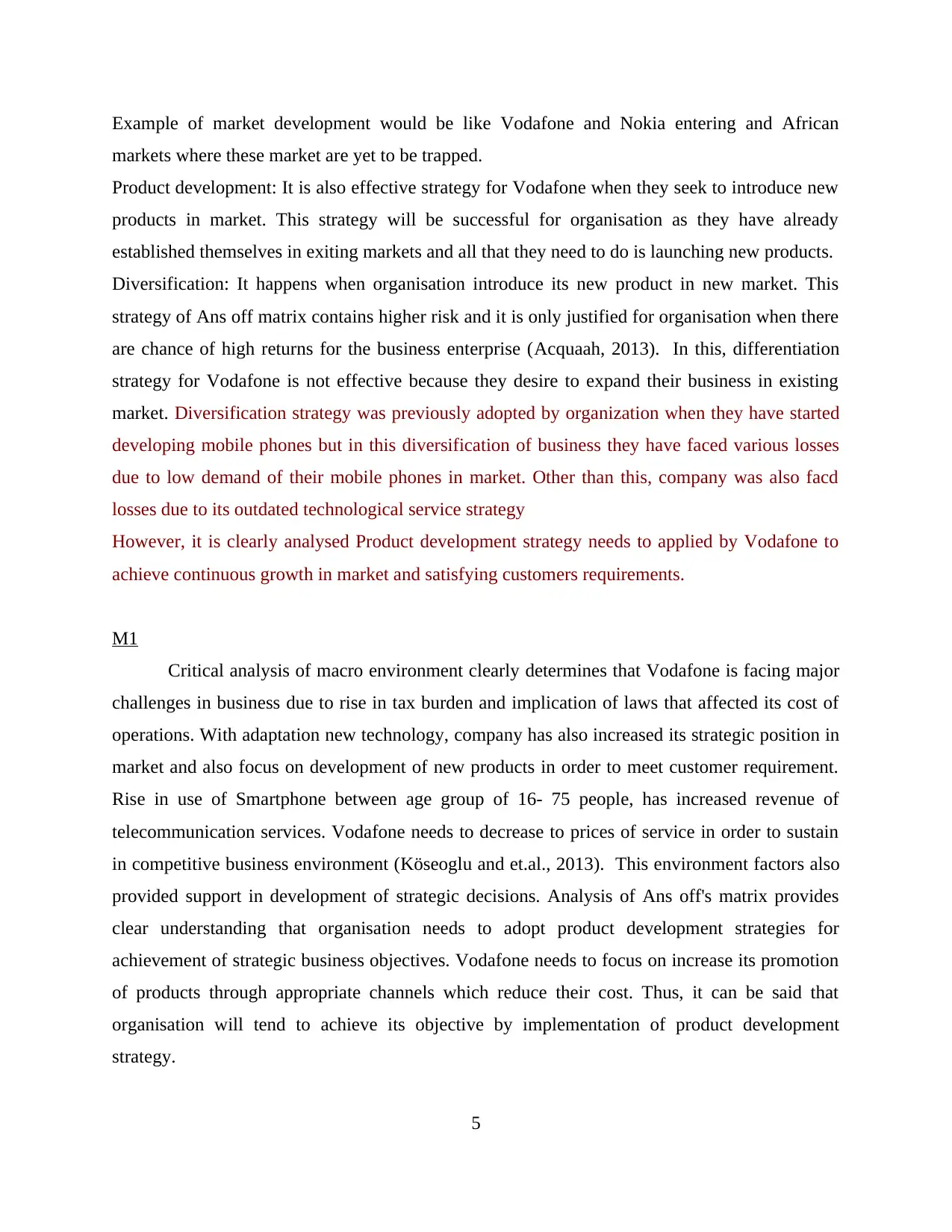
Example of market development would be like Vodafone and Nokia entering and African
markets where these market are yet to be trapped.
Product development: It is also effective strategy for Vodafone when they seek to introduce new
products in market. This strategy will be successful for organisation as they have already
established themselves in exiting markets and all that they need to do is launching new products.
Diversification: It happens when organisation introduce its new product in new market. This
strategy of Ans off matrix contains higher risk and it is only justified for organisation when there
are chance of high returns for the business enterprise (Acquaah, 2013). In this, differentiation
strategy for Vodafone is not effective because they desire to expand their business in existing
market. Diversification strategy was previously adopted by organization when they have started
developing mobile phones but in this diversification of business they have faced various losses
due to low demand of their mobile phones in market. Other than this, company was also facd
losses due to its outdated technological service strategy
However, it is clearly analysed Product development strategy needs to applied by Vodafone to
achieve continuous growth in market and satisfying customers requirements.
M1
Critical analysis of macro environment clearly determines that Vodafone is facing major
challenges in business due to rise in tax burden and implication of laws that affected its cost of
operations. With adaptation new technology, company has also increased its strategic position in
market and also focus on development of new products in order to meet customer requirement.
Rise in use of Smartphone between age group of 16- 75 people, has increased revenue of
telecommunication services. Vodafone needs to decrease to prices of service in order to sustain
in competitive business environment (Köseoglu and et.al., 2013). This environment factors also
provided support in development of strategic decisions. Analysis of Ans off's matrix provides
clear understanding that organisation needs to adopt product development strategies for
achievement of strategic business objectives. Vodafone needs to focus on increase its promotion
of products through appropriate channels which reduce their cost. Thus, it can be said that
organisation will tend to achieve its objective by implementation of product development
strategy.
5
markets where these market are yet to be trapped.
Product development: It is also effective strategy for Vodafone when they seek to introduce new
products in market. This strategy will be successful for organisation as they have already
established themselves in exiting markets and all that they need to do is launching new products.
Diversification: It happens when organisation introduce its new product in new market. This
strategy of Ans off matrix contains higher risk and it is only justified for organisation when there
are chance of high returns for the business enterprise (Acquaah, 2013). In this, differentiation
strategy for Vodafone is not effective because they desire to expand their business in existing
market. Diversification strategy was previously adopted by organization when they have started
developing mobile phones but in this diversification of business they have faced various losses
due to low demand of their mobile phones in market. Other than this, company was also facd
losses due to its outdated technological service strategy
However, it is clearly analysed Product development strategy needs to applied by Vodafone to
achieve continuous growth in market and satisfying customers requirements.
M1
Critical analysis of macro environment clearly determines that Vodafone is facing major
challenges in business due to rise in tax burden and implication of laws that affected its cost of
operations. With adaptation new technology, company has also increased its strategic position in
market and also focus on development of new products in order to meet customer requirement.
Rise in use of Smartphone between age group of 16- 75 people, has increased revenue of
telecommunication services. Vodafone needs to decrease to prices of service in order to sustain
in competitive business environment (Köseoglu and et.al., 2013). This environment factors also
provided support in development of strategic decisions. Analysis of Ans off's matrix provides
clear understanding that organisation needs to adopt product development strategies for
achievement of strategic business objectives. Vodafone needs to focus on increase its promotion
of products through appropriate channels which reduce their cost. Thus, it can be said that
organisation will tend to achieve its objective by implementation of product development
strategy.
5
Paraphrase This Document
Need a fresh take? Get an instant paraphrase of this document with our AI Paraphraser
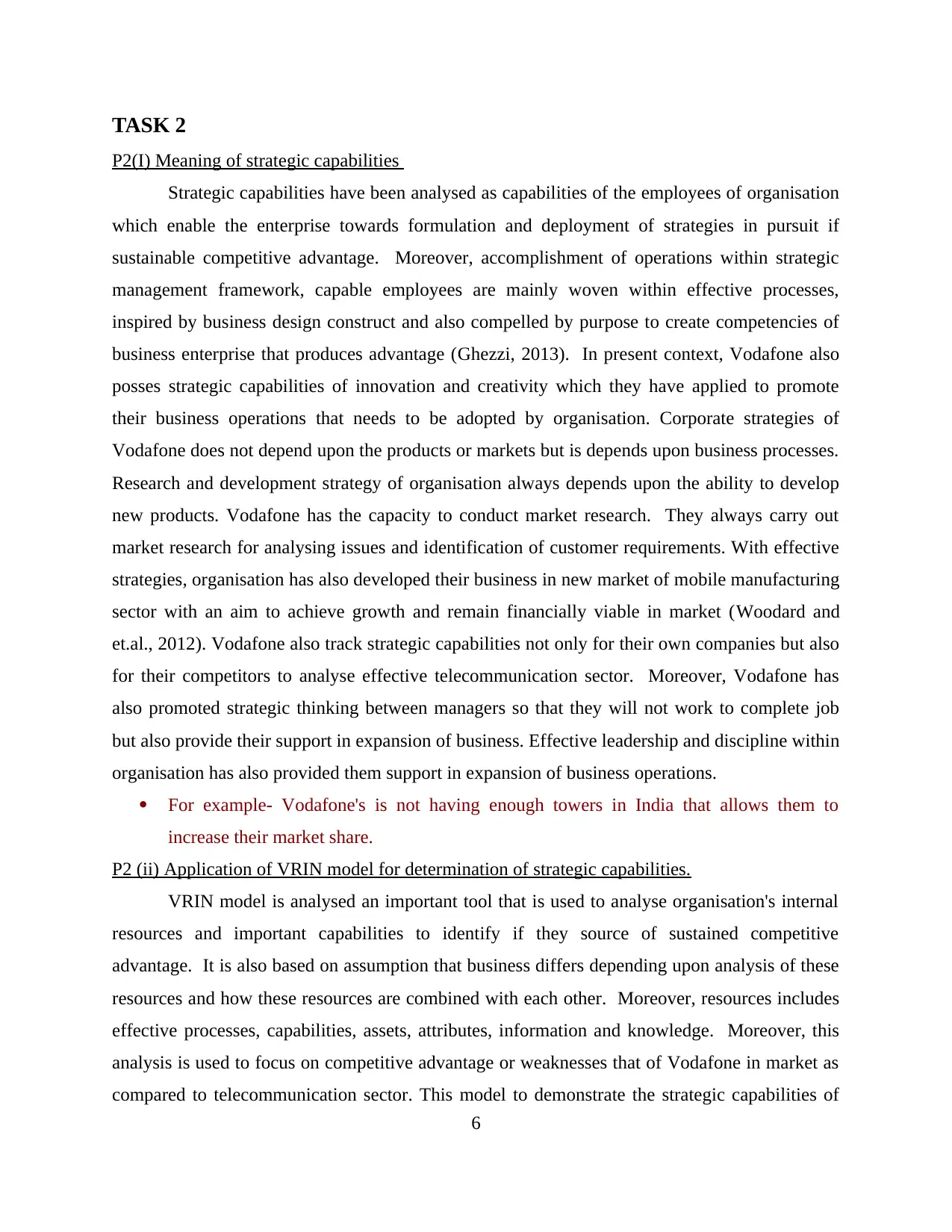
TASK 2
P2(I) Meaning of strategic capabilities
Strategic capabilities have been analysed as capabilities of the employees of organisation
which enable the enterprise towards formulation and deployment of strategies in pursuit if
sustainable competitive advantage. Moreover, accomplishment of operations within strategic
management framework, capable employees are mainly woven within effective processes,
inspired by business design construct and also compelled by purpose to create competencies of
business enterprise that produces advantage (Ghezzi, 2013). In present context, Vodafone also
posses strategic capabilities of innovation and creativity which they have applied to promote
their business operations that needs to be adopted by organisation. Corporate strategies of
Vodafone does not depend upon the products or markets but is depends upon business processes.
Research and development strategy of organisation always depends upon the ability to develop
new products. Vodafone has the capacity to conduct market research. They always carry out
market research for analysing issues and identification of customer requirements. With effective
strategies, organisation has also developed their business in new market of mobile manufacturing
sector with an aim to achieve growth and remain financially viable in market (Woodard and
et.al., 2012). Vodafone also track strategic capabilities not only for their own companies but also
for their competitors to analyse effective telecommunication sector. Moreover, Vodafone has
also promoted strategic thinking between managers so that they will not work to complete job
but also provide their support in expansion of business. Effective leadership and discipline within
organisation has also provided them support in expansion of business operations.
For example- Vodafone's is not having enough towers in India that allows them to
increase their market share.
P2 (ii) Application of VRIN model for determination of strategic capabilities.
VRIN model is analysed an important tool that is used to analyse organisation's internal
resources and important capabilities to identify if they source of sustained competitive
advantage. It is also based on assumption that business differs depending upon analysis of these
resources and how these resources are combined with each other. Moreover, resources includes
effective processes, capabilities, assets, attributes, information and knowledge. Moreover, this
analysis is used to focus on competitive advantage or weaknesses that of Vodafone in market as
compared to telecommunication sector. This model to demonstrate the strategic capabilities of
6
P2(I) Meaning of strategic capabilities
Strategic capabilities have been analysed as capabilities of the employees of organisation
which enable the enterprise towards formulation and deployment of strategies in pursuit if
sustainable competitive advantage. Moreover, accomplishment of operations within strategic
management framework, capable employees are mainly woven within effective processes,
inspired by business design construct and also compelled by purpose to create competencies of
business enterprise that produces advantage (Ghezzi, 2013). In present context, Vodafone also
posses strategic capabilities of innovation and creativity which they have applied to promote
their business operations that needs to be adopted by organisation. Corporate strategies of
Vodafone does not depend upon the products or markets but is depends upon business processes.
Research and development strategy of organisation always depends upon the ability to develop
new products. Vodafone has the capacity to conduct market research. They always carry out
market research for analysing issues and identification of customer requirements. With effective
strategies, organisation has also developed their business in new market of mobile manufacturing
sector with an aim to achieve growth and remain financially viable in market (Woodard and
et.al., 2012). Vodafone also track strategic capabilities not only for their own companies but also
for their competitors to analyse effective telecommunication sector. Moreover, Vodafone has
also promoted strategic thinking between managers so that they will not work to complete job
but also provide their support in expansion of business. Effective leadership and discipline within
organisation has also provided them support in expansion of business operations.
For example- Vodafone's is not having enough towers in India that allows them to
increase their market share.
P2 (ii) Application of VRIN model for determination of strategic capabilities.
VRIN model is analysed an important tool that is used to analyse organisation's internal
resources and important capabilities to identify if they source of sustained competitive
advantage. It is also based on assumption that business differs depending upon analysis of these
resources and how these resources are combined with each other. Moreover, resources includes
effective processes, capabilities, assets, attributes, information and knowledge. Moreover, this
analysis is used to focus on competitive advantage or weaknesses that of Vodafone in market as
compared to telecommunication sector. This model to demonstrate the strategic capabilities of
6
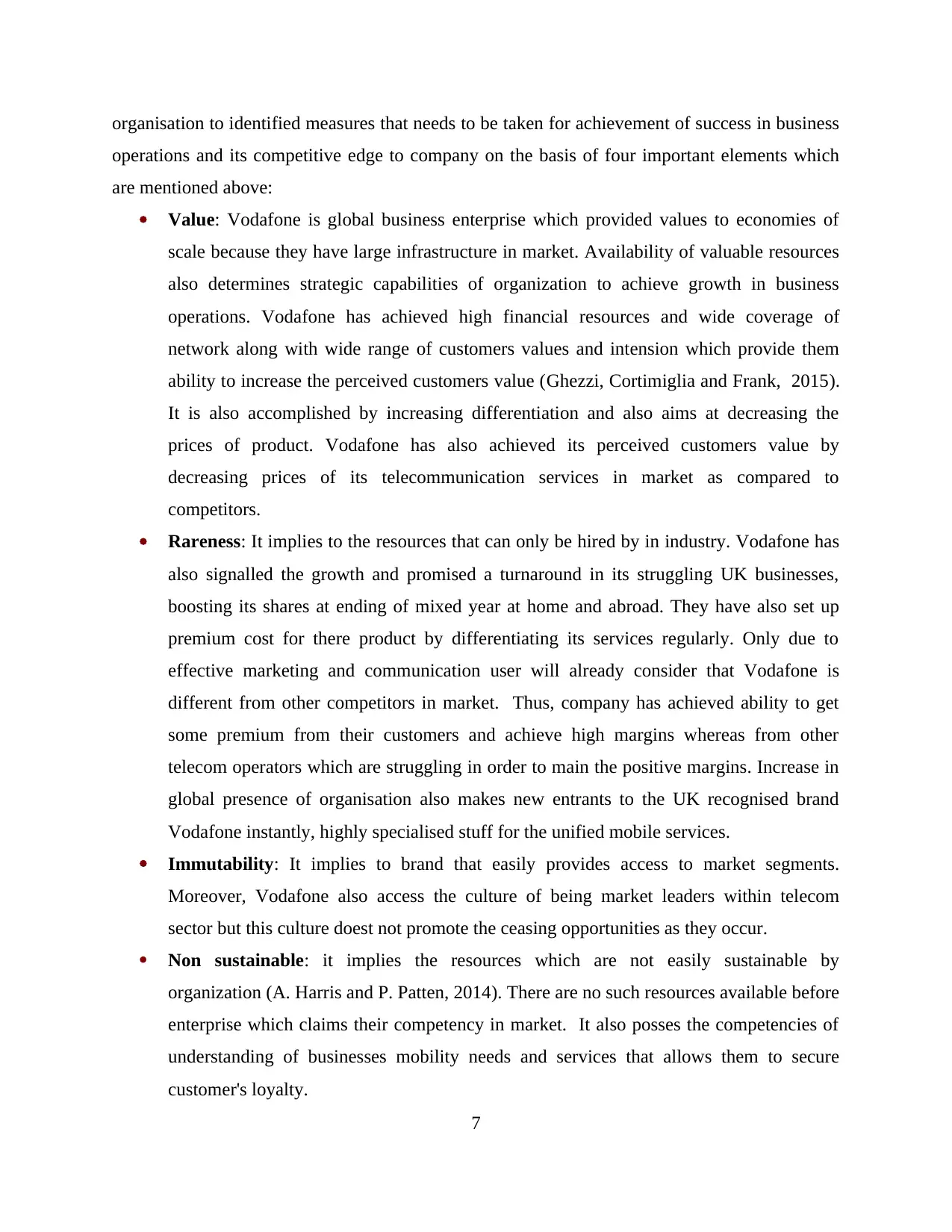
organisation to identified measures that needs to be taken for achievement of success in business
operations and its competitive edge to company on the basis of four important elements which
are mentioned above:
Value: Vodafone is global business enterprise which provided values to economies of
scale because they have large infrastructure in market. Availability of valuable resources
also determines strategic capabilities of organization to achieve growth in business
operations. Vodafone has achieved high financial resources and wide coverage of
network along with wide range of customers values and intension which provide them
ability to increase the perceived customers value (Ghezzi, Cortimiglia and Frank, 2015).
It is also accomplished by increasing differentiation and also aims at decreasing the
prices of product. Vodafone has also achieved its perceived customers value by
decreasing prices of its telecommunication services in market as compared to
competitors.
Rareness: It implies to the resources that can only be hired by in industry. Vodafone has
also signalled the growth and promised a turnaround in its struggling UK businesses,
boosting its shares at ending of mixed year at home and abroad. They have also set up
premium cost for there product by differentiating its services regularly. Only due to
effective marketing and communication user will already consider that Vodafone is
different from other competitors in market. Thus, company has achieved ability to get
some premium from their customers and achieve high margins whereas from other
telecom operators which are struggling in order to main the positive margins. Increase in
global presence of organisation also makes new entrants to the UK recognised brand
Vodafone instantly, highly specialised stuff for the unified mobile services.
Immutability: It implies to brand that easily provides access to market segments.
Moreover, Vodafone also access the culture of being market leaders within telecom
sector but this culture doest not promote the ceasing opportunities as they occur.
Non sustainable: it implies the resources which are not easily sustainable by
organization (A. Harris and P. Patten, 2014). There are no such resources available before
enterprise which claims their competency in market. It also posses the competencies of
understanding of businesses mobility needs and services that allows them to secure
customer's loyalty.
7
operations and its competitive edge to company on the basis of four important elements which
are mentioned above:
Value: Vodafone is global business enterprise which provided values to economies of
scale because they have large infrastructure in market. Availability of valuable resources
also determines strategic capabilities of organization to achieve growth in business
operations. Vodafone has achieved high financial resources and wide coverage of
network along with wide range of customers values and intension which provide them
ability to increase the perceived customers value (Ghezzi, Cortimiglia and Frank, 2015).
It is also accomplished by increasing differentiation and also aims at decreasing the
prices of product. Vodafone has also achieved its perceived customers value by
decreasing prices of its telecommunication services in market as compared to
competitors.
Rareness: It implies to the resources that can only be hired by in industry. Vodafone has
also signalled the growth and promised a turnaround in its struggling UK businesses,
boosting its shares at ending of mixed year at home and abroad. They have also set up
premium cost for there product by differentiating its services regularly. Only due to
effective marketing and communication user will already consider that Vodafone is
different from other competitors in market. Thus, company has achieved ability to get
some premium from their customers and achieve high margins whereas from other
telecom operators which are struggling in order to main the positive margins. Increase in
global presence of organisation also makes new entrants to the UK recognised brand
Vodafone instantly, highly specialised stuff for the unified mobile services.
Immutability: It implies to brand that easily provides access to market segments.
Moreover, Vodafone also access the culture of being market leaders within telecom
sector but this culture doest not promote the ceasing opportunities as they occur.
Non sustainable: it implies the resources which are not easily sustainable by
organization (A. Harris and P. Patten, 2014). There are no such resources available before
enterprise which claims their competency in market. It also posses the competencies of
understanding of businesses mobility needs and services that allows them to secure
customer's loyalty.
7
⊘ This is a preview!⊘
Do you want full access?
Subscribe today to unlock all pages.

Trusted by 1+ million students worldwide
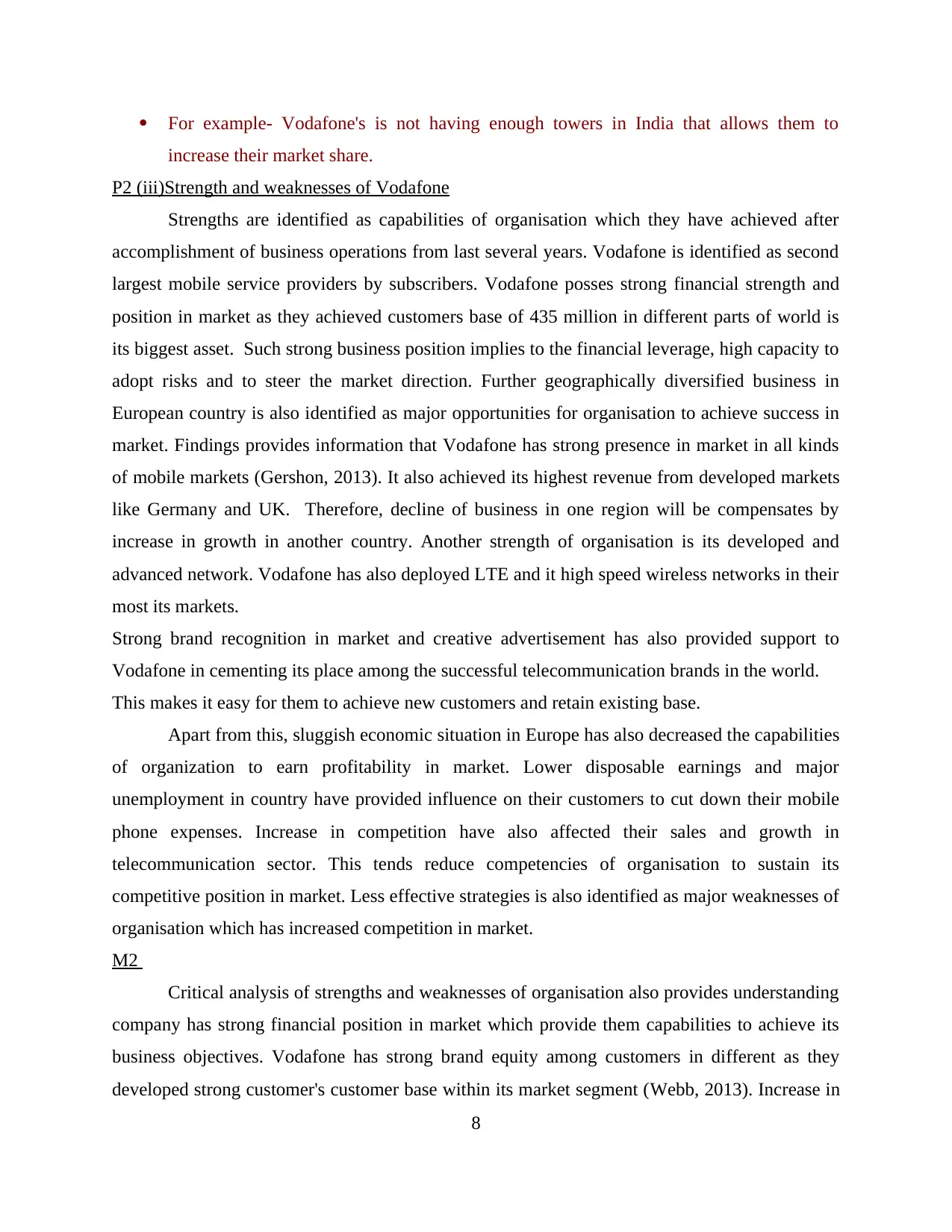
For example- Vodafone's is not having enough towers in India that allows them to
increase their market share.
P2 (iii)Strength and weaknesses of Vodafone
Strengths are identified as capabilities of organisation which they have achieved after
accomplishment of business operations from last several years. Vodafone is identified as second
largest mobile service providers by subscribers. Vodafone posses strong financial strength and
position in market as they achieved customers base of 435 million in different parts of world is
its biggest asset. Such strong business position implies to the financial leverage, high capacity to
adopt risks and to steer the market direction. Further geographically diversified business in
European country is also identified as major opportunities for organisation to achieve success in
market. Findings provides information that Vodafone has strong presence in market in all kinds
of mobile markets (Gershon, 2013). It also achieved its highest revenue from developed markets
like Germany and UK. Therefore, decline of business in one region will be compensates by
increase in growth in another country. Another strength of organisation is its developed and
advanced network. Vodafone has also deployed LTE and it high speed wireless networks in their
most its markets.
Strong brand recognition in market and creative advertisement has also provided support to
Vodafone in cementing its place among the successful telecommunication brands in the world.
This makes it easy for them to achieve new customers and retain existing base.
Apart from this, sluggish economic situation in Europe has also decreased the capabilities
of organization to earn profitability in market. Lower disposable earnings and major
unemployment in country have provided influence on their customers to cut down their mobile
phone expenses. Increase in competition have also affected their sales and growth in
telecommunication sector. This tends reduce competencies of organisation to sustain its
competitive position in market. Less effective strategies is also identified as major weaknesses of
organisation which has increased competition in market.
M2
Critical analysis of strengths and weaknesses of organisation also provides understanding
company has strong financial position in market which provide them capabilities to achieve its
business objectives. Vodafone has strong brand equity among customers in different as they
developed strong customer's customer base within its market segment (Webb, 2013). Increase in
8
increase their market share.
P2 (iii)Strength and weaknesses of Vodafone
Strengths are identified as capabilities of organisation which they have achieved after
accomplishment of business operations from last several years. Vodafone is identified as second
largest mobile service providers by subscribers. Vodafone posses strong financial strength and
position in market as they achieved customers base of 435 million in different parts of world is
its biggest asset. Such strong business position implies to the financial leverage, high capacity to
adopt risks and to steer the market direction. Further geographically diversified business in
European country is also identified as major opportunities for organisation to achieve success in
market. Findings provides information that Vodafone has strong presence in market in all kinds
of mobile markets (Gershon, 2013). It also achieved its highest revenue from developed markets
like Germany and UK. Therefore, decline of business in one region will be compensates by
increase in growth in another country. Another strength of organisation is its developed and
advanced network. Vodafone has also deployed LTE and it high speed wireless networks in their
most its markets.
Strong brand recognition in market and creative advertisement has also provided support to
Vodafone in cementing its place among the successful telecommunication brands in the world.
This makes it easy for them to achieve new customers and retain existing base.
Apart from this, sluggish economic situation in Europe has also decreased the capabilities
of organization to earn profitability in market. Lower disposable earnings and major
unemployment in country have provided influence on their customers to cut down their mobile
phone expenses. Increase in competition have also affected their sales and growth in
telecommunication sector. This tends reduce competencies of organisation to sustain its
competitive position in market. Less effective strategies is also identified as major weaknesses of
organisation which has increased competition in market.
M2
Critical analysis of strengths and weaknesses of organisation also provides understanding
company has strong financial position in market which provide them capabilities to achieve its
business objectives. Vodafone has strong brand equity among customers in different as they
developed strong customer's customer base within its market segment (Webb, 2013). Increase in
8
Paraphrase This Document
Need a fresh take? Get an instant paraphrase of this document with our AI Paraphraser
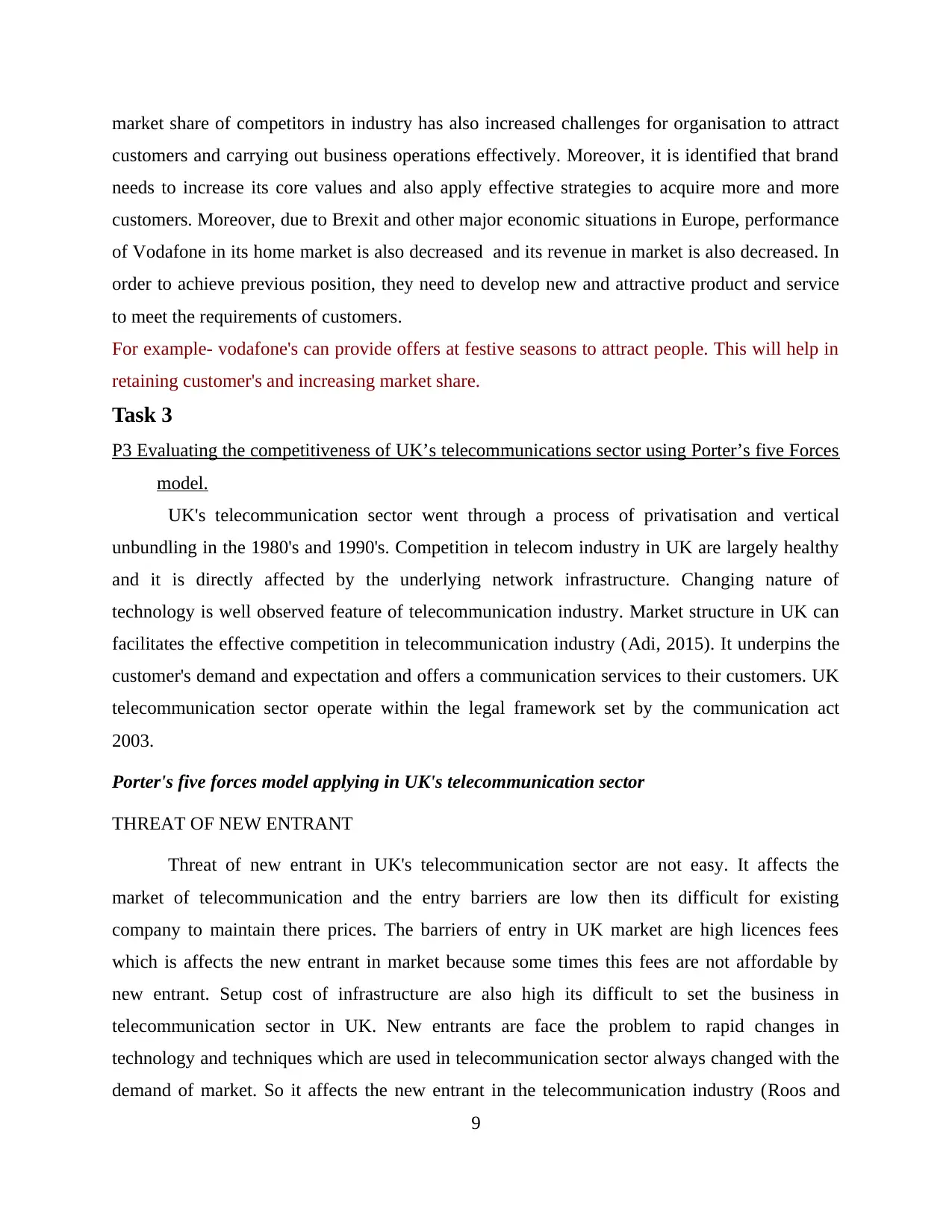
market share of competitors in industry has also increased challenges for organisation to attract
customers and carrying out business operations effectively. Moreover, it is identified that brand
needs to increase its core values and also apply effective strategies to acquire more and more
customers. Moreover, due to Brexit and other major economic situations in Europe, performance
of Vodafone in its home market is also decreased and its revenue in market is also decreased. In
order to achieve previous position, they need to develop new and attractive product and service
to meet the requirements of customers.
For example- vodafone's can provide offers at festive seasons to attract people. This will help in
retaining customer's and increasing market share.
Task 3
P3 Evaluating the competitiveness of UK’s telecommunications sector using Porter’s five Forces
model.
UK's telecommunication sector went through a process of privatisation and vertical
unbundling in the 1980's and 1990's. Competition in telecom industry in UK are largely healthy
and it is directly affected by the underlying network infrastructure. Changing nature of
technology is well observed feature of telecommunication industry. Market structure in UK can
facilitates the effective competition in telecommunication industry (Adi, 2015). It underpins the
customer's demand and expectation and offers a communication services to their customers. UK
telecommunication sector operate within the legal framework set by the communication act
2003.
Porter's five forces model applying in UK's telecommunication sector
THREAT OF NEW ENTRANT
Threat of new entrant in UK's telecommunication sector are not easy. It affects the
market of telecommunication and the entry barriers are low then its difficult for existing
company to maintain there prices. The barriers of entry in UK market are high licences fees
which is affects the new entrant in market because some times this fees are not affordable by
new entrant. Setup cost of infrastructure are also high its difficult to set the business in
telecommunication sector in UK. New entrants are face the problem to rapid changes in
technology and techniques which are used in telecommunication sector always changed with the
demand of market. So it affects the new entrant in the telecommunication industry (Roos and
9
customers and carrying out business operations effectively. Moreover, it is identified that brand
needs to increase its core values and also apply effective strategies to acquire more and more
customers. Moreover, due to Brexit and other major economic situations in Europe, performance
of Vodafone in its home market is also decreased and its revenue in market is also decreased. In
order to achieve previous position, they need to develop new and attractive product and service
to meet the requirements of customers.
For example- vodafone's can provide offers at festive seasons to attract people. This will help in
retaining customer's and increasing market share.
Task 3
P3 Evaluating the competitiveness of UK’s telecommunications sector using Porter’s five Forces
model.
UK's telecommunication sector went through a process of privatisation and vertical
unbundling in the 1980's and 1990's. Competition in telecom industry in UK are largely healthy
and it is directly affected by the underlying network infrastructure. Changing nature of
technology is well observed feature of telecommunication industry. Market structure in UK can
facilitates the effective competition in telecommunication industry (Adi, 2015). It underpins the
customer's demand and expectation and offers a communication services to their customers. UK
telecommunication sector operate within the legal framework set by the communication act
2003.
Porter's five forces model applying in UK's telecommunication sector
THREAT OF NEW ENTRANT
Threat of new entrant in UK's telecommunication sector are not easy. It affects the
market of telecommunication and the entry barriers are low then its difficult for existing
company to maintain there prices. The barriers of entry in UK market are high licences fees
which is affects the new entrant in market because some times this fees are not affordable by
new entrant. Setup cost of infrastructure are also high its difficult to set the business in
telecommunication sector in UK. New entrants are face the problem to rapid changes in
technology and techniques which are used in telecommunication sector always changed with the
demand of market. So it affects the new entrant in the telecommunication industry (Roos and
9
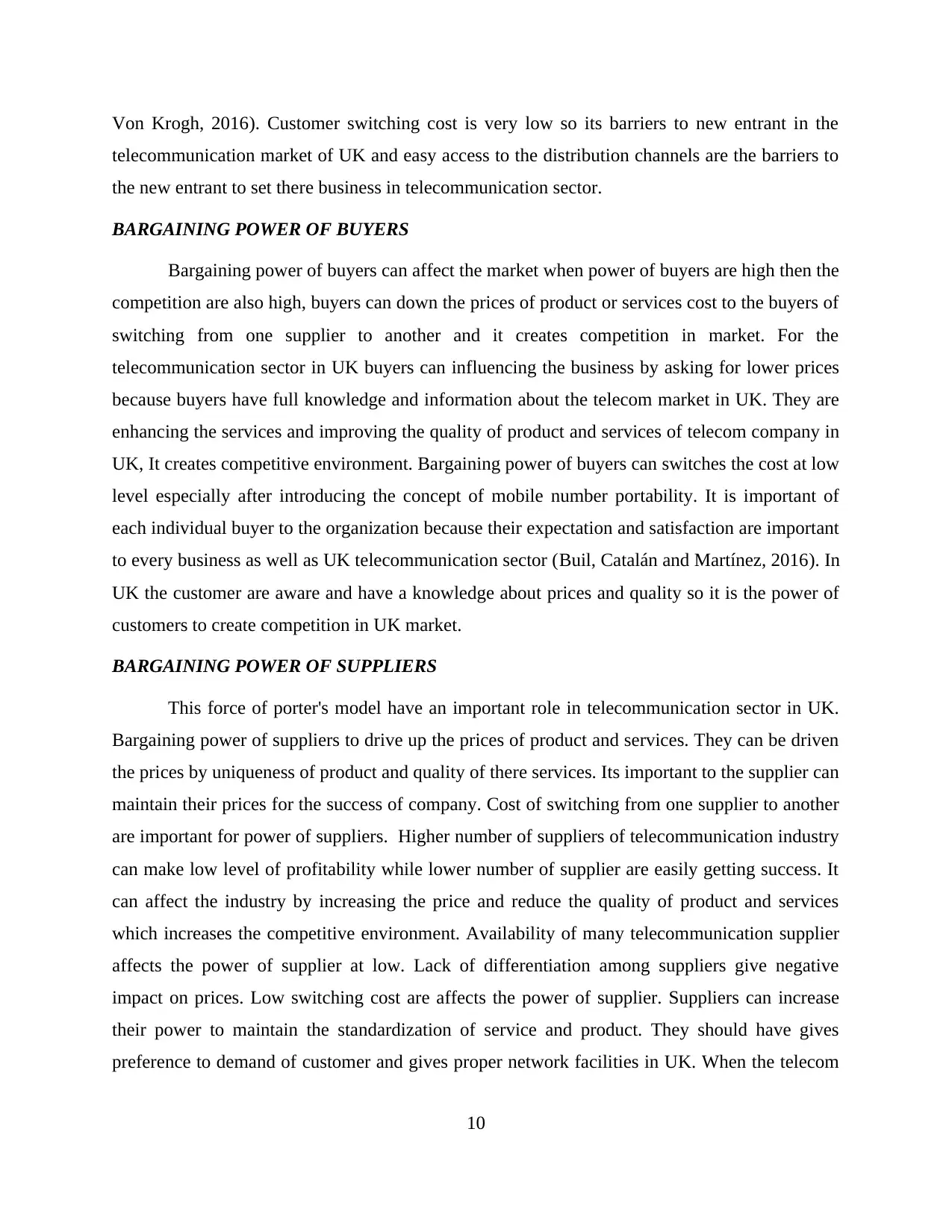
Von Krogh, 2016). Customer switching cost is very low so its barriers to new entrant in the
telecommunication market of UK and easy access to the distribution channels are the barriers to
the new entrant to set there business in telecommunication sector.
BARGAINING POWER OF BUYERS
Bargaining power of buyers can affect the market when power of buyers are high then the
competition are also high, buyers can down the prices of product or services cost to the buyers of
switching from one supplier to another and it creates competition in market. For the
telecommunication sector in UK buyers can influencing the business by asking for lower prices
because buyers have full knowledge and information about the telecom market in UK. They are
enhancing the services and improving the quality of product and services of telecom company in
UK, It creates competitive environment. Bargaining power of buyers can switches the cost at low
level especially after introducing the concept of mobile number portability. It is important of
each individual buyer to the organization because their expectation and satisfaction are important
to every business as well as UK telecommunication sector (Buil, Catalán and Martínez, 2016). In
UK the customer are aware and have a knowledge about prices and quality so it is the power of
customers to create competition in UK market.
BARGAINING POWER OF SUPPLIERS
This force of porter's model have an important role in telecommunication sector in UK.
Bargaining power of suppliers to drive up the prices of product and services. They can be driven
the prices by uniqueness of product and quality of there services. Its important to the supplier can
maintain their prices for the success of company. Cost of switching from one supplier to another
are important for power of suppliers. Higher number of suppliers of telecommunication industry
can make low level of profitability while lower number of supplier are easily getting success. It
can affect the industry by increasing the price and reduce the quality of product and services
which increases the competitive environment. Availability of many telecommunication supplier
affects the power of supplier at low. Lack of differentiation among suppliers give negative
impact on prices. Low switching cost are affects the power of supplier. Suppliers can increase
their power to maintain the standardization of service and product. They should have gives
preference to demand of customer and gives proper network facilities in UK. When the telecom
10
telecommunication market of UK and easy access to the distribution channels are the barriers to
the new entrant to set there business in telecommunication sector.
BARGAINING POWER OF BUYERS
Bargaining power of buyers can affect the market when power of buyers are high then the
competition are also high, buyers can down the prices of product or services cost to the buyers of
switching from one supplier to another and it creates competition in market. For the
telecommunication sector in UK buyers can influencing the business by asking for lower prices
because buyers have full knowledge and information about the telecom market in UK. They are
enhancing the services and improving the quality of product and services of telecom company in
UK, It creates competitive environment. Bargaining power of buyers can switches the cost at low
level especially after introducing the concept of mobile number portability. It is important of
each individual buyer to the organization because their expectation and satisfaction are important
to every business as well as UK telecommunication sector (Buil, Catalán and Martínez, 2016). In
UK the customer are aware and have a knowledge about prices and quality so it is the power of
customers to create competition in UK market.
BARGAINING POWER OF SUPPLIERS
This force of porter's model have an important role in telecommunication sector in UK.
Bargaining power of suppliers to drive up the prices of product and services. They can be driven
the prices by uniqueness of product and quality of there services. Its important to the supplier can
maintain their prices for the success of company. Cost of switching from one supplier to another
are important for power of suppliers. Higher number of suppliers of telecommunication industry
can make low level of profitability while lower number of supplier are easily getting success. It
can affect the industry by increasing the price and reduce the quality of product and services
which increases the competitive environment. Availability of many telecommunication supplier
affects the power of supplier at low. Lack of differentiation among suppliers give negative
impact on prices. Low switching cost are affects the power of supplier. Suppliers can increase
their power to maintain the standardization of service and product. They should have gives
preference to demand of customer and gives proper network facilities in UK. When the telecom
10
⊘ This is a preview!⊘
Do you want full access?
Subscribe today to unlock all pages.

Trusted by 1+ million students worldwide
1 out of 19
Related Documents
Your All-in-One AI-Powered Toolkit for Academic Success.
+13062052269
info@desklib.com
Available 24*7 on WhatsApp / Email
![[object Object]](/_next/static/media/star-bottom.7253800d.svg)
Unlock your academic potential
Copyright © 2020–2025 A2Z Services. All Rights Reserved. Developed and managed by ZUCOL.





